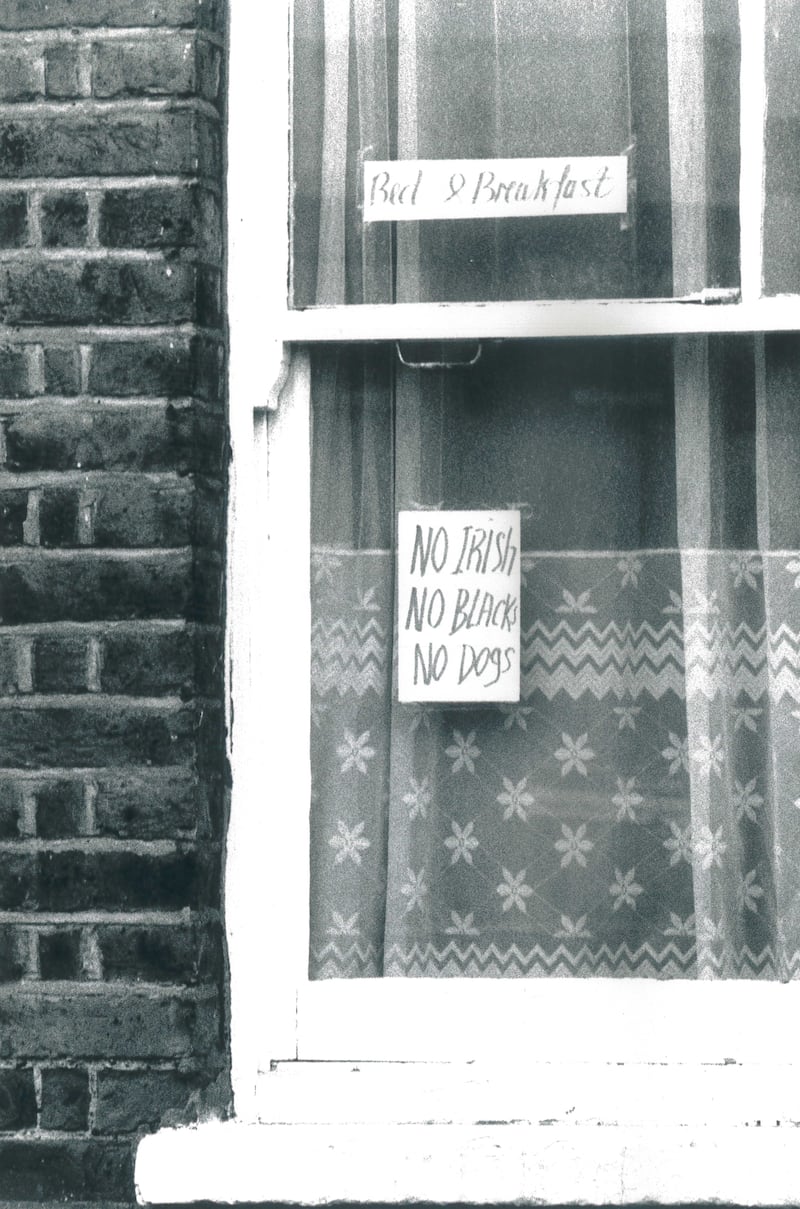Absence of proof is not proof of absence, theologians like to say. What applies to the existence of God also pertains to historical fact. We know events occurred even if we lack scientific-grade evidence for them.
The point relates to an emotive question in Irish social history: Did the signs purportedly placed in lodgings across Britain 50-plus years ago, “No Irish, No Blacks, No Dogs”, actually exist? And, if so, how prevalent were they?
Raising the issue risks causing some offence. A retired American history professor created a storm a decade ago when he published a paper questioning the extent to which “No Irish Need Apply” (NINA) notices existed in the United States in the mid-19th century. His argument that there was “a myth of victimisation” fast unravelled when a 14-year-old high school student discovered widespread circulation of the NINA phrase in newspaper notices right up to the 20th century.
The story of the Irish in America is, of course, a complicated one. “In the 19th century the Irish were seen as racially backward”, but over time “the Irish began acquiring their whiteness… in part through their role in the enforcement of workplace colour bars against blacks”, writes Kenan Malik in his book Not So Black and White.
As for the Irish in Britain, “complicated” doesn’t do it justice. Anti-Irish discrimination took on many forms over the centuries. However, drawing parallels between such prejudice and the kind of racism people of colour have experienced remains contentious.

Regarding “No Irish, No Blacks, No Dogs”, the only known photograph of such a sign is from an unknown source – the image having been donated to the archive of Irish in Britain, a research and support group for the diaspora which is now more than 50 years old. An exhibition featuring the famous picture and other material from the archive opened this month at the Epic Museum in Dublin and is on show until July 14th.
The provenance of the photograph was the subject of some debate in 2015, triggered by a London-based history enthusiast who wrote a letter to The Guardian newspaper questioning the authenticity of the image and saying it was a “myth” that such signs were commonplace in the postwar years.
[ The story of the Irish in Britain comes ‘home home’Opens in new window ]
In response, Irish in Britain archive curator Dr Tony Murray, who is based at London Metropolitan University, explained the photograph was donated “sometime in the early 1980s” to an Irish history group which in turn passed it on to the archive. “With community ventures of this kind, such items are not always formally acquisitioned and their provenance not always recorded,” Murray wrote but the archive has “no reason to doubt the authenticity”.
[ Bombings, beatings, anti-Irish racism, and dreaming of being an astronautOpens in new window ]
Among those to chip in on the debate was Prof Steve Bruce, a sociologist at University of Aberdeen, who wrote: “If ‘No Irish’ signs were as common as is asserted, there should be plenty of them remaining in private collections, local archives and the like… Can we please see some?”
I don’t think the sometimes-obsessive preoccupation with the authenticity of one particular image, or for that matter with the particular combination of words found on similar images, contributes a great deal
— Dr Tony Murray, London Metropolitan University
Speaking to The Irish Times last year on the matter, Bruce – who has extensively researched sectarianism in Scotland – said following his public plea that “nobody ever replied with evidence”.
He added: “I have always been suspicious of dramatic illustrations of complex points. If it is too good to be true... etc. I spend a lot of my time saying ‘I think you’ll find it’s a bit more complicated than that’.”
Against this, there are many Irish people who testify to having seen “No Irish” signs. One woman who gave a statement to the Irish in Britain archive described visiting a pub near Birmingham in the 1970s where her mother worked: “I can clearly remember a painted black sign next to the front door that said, in large white letters, ‘No Irish’, and underneath in smaller writing ‘No Dogs’.”
Sharing such testimony last week, Murray said it was “particularly significant because it provides persuasive evidence that such signs existed in Britain well into the 1970s”. He highlighted a number of similar recollections from Irish emigrants, while also pointing to documentary footage – seemingly from about 60 years ago – that showed a rental notice containing the words “no coloured, no Irish, no children”. The source of the footage is uncertain but “I am investigating this further”, he said.
At the heart of the debate is a wider question of how history should be done. In recent decades, greater emphasis has been put on oral history as a means of giving a voice to people who were typically written out of academic textbooks. The approach, however, can clash with traditional, records-based research, a case in point being the report of the Commission of Investigation into Mother and Baby Homes.
In one of its headline findings, the commission said it had “not seen any evidence that the religious orders who ran the mother and baby homes made a profit from so doing”. But survivors argued that the inquiry – which followed a relatively conventional methodology, drawing on multiple sources – did not give sufficient weight to their testimony as unpaid labourers.
[ The racism that has always lurked within the Irish has been exposedOpens in new window ]
Murray says: “Personal testimony is increasingly regarded by historians as legitimate primary-source evidence in a way which was not so much the case in the past. This is because they now recognise that for hitherto underrepresented groups in society, there are practical, economic and cultural reasons why there are often very few written primary-source accounts of their experience.”
Of course, oral testimony may not always be accurate. So when exploring the varied and multilayered experience of the Irish in Britain – an experience the Epic exhibition richly captures – there is a need for balanced judgment as well as an open mind.

Regarding the famous photograph, Murray says: “Despite our continuing best efforts, we have no further hard evidence of the originator of the image nor where/when it was taken… Ultimately, I don’t think the sometimes-obsessive preoccupation with the authenticity of one particular image, or for that matter with the particular combination of words found on similar images, contributes a great deal. However, if such debates draw attention to the wider and more substantial testimonies of anti-Irish discrimination in Britain, then this may be no bad thing.”














